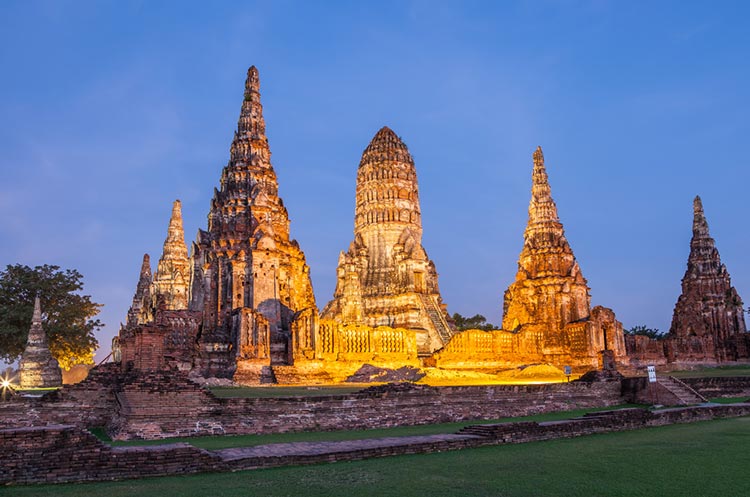
Ayutthaya Kingdom History
The Ayutthaya Kingdom was founded in 1351 by King Ramathibodi I, also known as U-Thong. It was the second Thai empire, after Sukhothai. At the height of its power, Ayutthaya was one of the world’s largest and wealthiest cities with over a million inhabitants.
The city was built on an island surrounded by three rivers, The Chao Phraya, the Pa Sak and the Lopburi river that served as a natural barrier against invaders. Ayutthaya was connected to the Gulf of Siam about 100 kilometers South by the Chao Phraya river.
A number of palaces and many imposing temples were built. Architecture and art were influenced by neighboring empires as Sukhothai and Angkor, as well as China, Japan and several European countries. One of the most clear examples of foreign influence is the large Angkor style prangs like the ones of the Wat Ratchaburana and the Wat Chaiwatthanaram.
Foreign trade settlements
Ayutthaya was a center of international trade which brought a great deal of prosperity. As foreigners were not allowed to live on the island, several countries including Holland, Portugal and Japan built settlements just off the island.
Wars with rival empires
During the over four centuries of its existence many wars were fought with rival Kingdoms as Sukhothai, Burma and Angkor. In 1431 Ayutthaya invaded Angkor ending the Khmer empire that had dominated much of South East Asia for centuries. Halfway the 15th century Sukhothai, the first independent Thai Kingdom had weakened and was unified with Ayutthaya.
Several wars were fought with Burma during the second half of the 16th century. In 1569 the Burmese invaded Ayutthaya, captured the Royal Family and took them to Pegu (present day Bago) in Burma. A few decades later during the reign of King Naresuan, the Burmese were driven out and Ayutthaya regained its independence.
The reign of King Narai the Great during the second half of the 17th century was a time of great prosperity. The King established a second capital of the Kingdom in Lopburi, where he built a new palace.
Fall of the Ayutthaya Kingdom
Finally the Ayutthaya Kingdom ended in 1767 when the Burmese invaded and destroyed the city. The city was not rebuild; instead the Thais moved their capital further South to Thonburi. It took until the end of the 1960’s when the Thai Fine Arts Department began with the restoration works in Ayutthaya.
Today a number of temples have been restored that give a good impression of the Kingdom’s wealth. In 1991 the historical park was declared a UNESCO World Heritage Site.
Museums in the Ayutthaya Historical Park
On the island are several museums that provide insight in the history of the Ayutthaya empire including the Chao Sam Phraya National Museum, Chandra Kasem National Museum and the Ayutthaya Historical Study Center.
Ayutthaya Historical Study Center
The Ayutthaya Historical Study Center is an institute that studies the history of the old Kingdom. The center’s displays inform the visitor about the history of the Ayutthaya Kingdom, art, culture, Buddhism and relations with other countries.
The study center is located on Rochana road, across the street from the Chao Sam Phraya National Museum. Opening hours are daily from 9 am until 5 pm, admission is 100 Baht.
Temples in the Ayutthaya Historical Park
Ayutthaya Historical Park Tours
- From Bangkok
- Private or group tour
- Also visit other highlights like Bang Pa-In Summer Palace